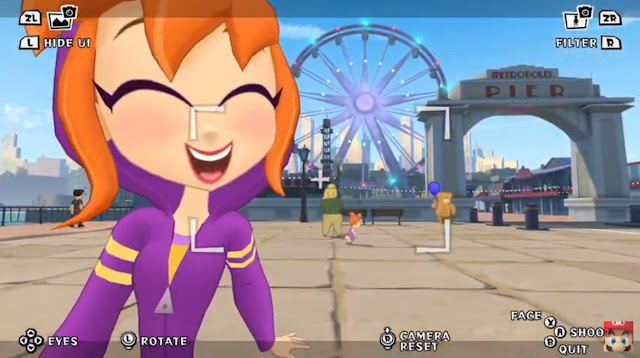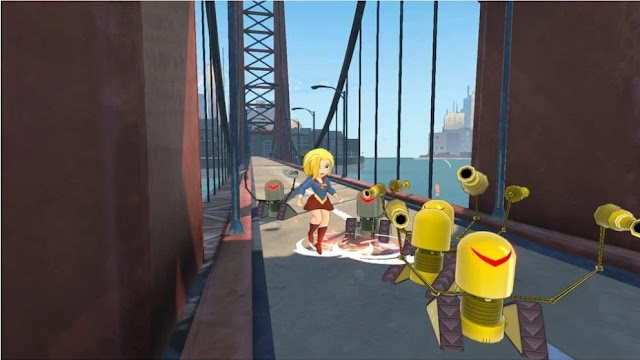This review is going to be pretty negative, so there’s something I want to say up front: I think that it is a wonderful thing that Nintendo published DC Super Hero Girls: Teen Power. There is a simple reality here that the big publishers do very little to reach out to the young-through-teen girls market. Take a good, close look at the libraries of Activision, EA, Sony, Microsoft, Ubisoft, Square Enix and etc: There’s plenty there for adults and a fair bit of that crosses over to be stuff that boys will like (even if responsible parents shouldn’t be letting them play them). Games that are specifically for girls, though? Not to any meaningful standard. For everything I am about to write DC Super Hero Girls: Teen Power is a particularly well-made game for that specific demographic. Nintendo deserves credit for going out of its way to take it on as a publishing project.
Unfortunately, while Nintendo is doing the right thing in finding a game designed for girls, the fact that DC Super Hero Girls: Teen Power is made for girls is actually deeply concerning. The presence of this property at all suggests some less-than-pleasant things about western popular culture, and while the game does a good job of taking the property and turning it into the game, I do question the value of the property itself existing in the first instance.
Getting to the crux of it; whoever designed DC Super Hero Girls: Teen Power took one look at the way western comics like DC and Marvel worked, and figured that the best way to appeal to girls was to simply leave every ideological leaning to these adult properties untouched, and instead attach a weird modern valley girl vibe as though the aesthetics were the only thing that needed changing to make DC good for girls (and before anyone says anything I have similar criticisms about the kids’ comics made for boys, but I’m not reviewing one of those right here). To put it another way, the genuinely contentious themes within the DC universe haven’t been touched. There’s still the unquestioned association between vigilantism and heroism. There’s still the blasé way that this stuff treats collateral damage (everything’s fine as long as the bad guys get beat!) and this series definitely wants young girls to think that individualism is the only right state of being.
If anything, the Teen Power stuff is even more obnoxious about this stuff, because, for all their many (many) faults, the Zach Snyder and Christopher Nolan films do, at least, raise these questions. They do it superficially, and they ultimately affirm that the kind of libertarian individualistic vigilantism that Ayn Rand would be proud of. They ultimately decide that it is in fact the right state of things that we see these paragons of individualism as heroes, but they do at least raise the question. Teen Power simply encourages kids to get on board with this without the question. Look. It’s a simple truth that the entertainment that children experience shapes their view of the world. Alongside parenting and school, the arts are a source of education, and the deeply conservative ideology that DC and Marvel represent doesn’t suddenly become something to accept uncritically just because it can be presented as something empowering for kids. The fact that the underlying ideology of DC is laid so bare here is something that people should be paying attention to. As a society we don’t, because we’re all far too comfortable with indoctrinating children into this stuff, so long as the storytelling hits the right notes around “representation” and “positivity.” But we should care nonetheless.
Teen Power also plays deeply into the shallower side of popular culture, acting to, again, normalise it without question. We – adults – can sit here and discuss the pros and cons of social media, the shortening attention spans that they promote, and the reliance on a culture of vapid rewards that selfies and “likes” promote. We – adults – can use it with an appropriate awareness of it. However, when it’s dropped in a game like Teen Power, it’s simply placed there as a celebration of the various rituals. There’s no conversation in the game. It’s just a fun source of side quests and mini-games. You can see that the game is a response to a modern youth culture desperately short on focus, too: every objective that the game gives you, it repeats in triplicate, just to make sure you didn’t miss the instruction. I’m not exaggerating. Here’s how just about every conversation goes: “Oh, right? I shoud post this on Supersta!” “What’s that?” “On Supersta you can post your own pictures for everyone to see!” “That’s nice! Perhaps I should post something on Supersta.” Yes, very good, game. I now understand that I should post pictures on Supersta.
Now, with all of that said, the game is a lot of fun, and it’s well-made and well-executed for the target demographic. I could sit here and bellyache about how the combat is clunky and limited, how the boss battles are overly simple, and that sometimes the tutorials requires are a little too vague for their own good. Other people might comment that though the game is “open world”, it’s of a limited type with relatively few things to do (I actually like that). Whatever the criticisms we might direct at the game’s design as adults, though, the target demographic will love the combination of pacing calibrated to their skill level, short, sharp missions, and the lack of an overwhelming number of distractions. This is, again, a game that was specifically made for children in mind, and in that context, I can’t actually think of something that takes an “adult” gameplay structure (open world action-adventure) and makes it palatable for a younger audience. Usually when developers try this it’s barely playable, but here it’s spot-on.
There’s a nice mix of heroes to use, too, and they all feel substantially different to one another, with special abilities that nicely encapsulate what their counterparts would normally be doing. Supergirl has flight. Wonder Woman has her shield, and so on. Naturally, the difficulty is pitched low (though, again, for the target demographic it would likely hit the right balance of challenge and reward), and there are all the little progression features from the genre that have been streamlined down in an attractive way. There are levelling systems, alternative costumes, and all that other good stuff that you naturally expect to find in this kind of game. It’s all just made intelligible to the youngest of players.
My concerns with DC Super Hero Girls: Teen Power sit with it as a property. I know this is a wildly controversial thing to say, but I don’t really believe that Marvel and DC are appropriate for children. If the hundreds of implied and explicit deaths per movie or show weren’t enough to convince you of that, then the inherent moral lessons from these properties should because there’s a lot more there to digest, interpret and come to terms with than people generally think about. Making all that baggage cute, as DC Super Hero Girls: Teen Power does, might make it palatable to a young audience, but it still needs to be questioned. That being said, at least it’s not Call of Duty, which way too many people buy for their kids, and as I said at the start, both Nintendo and the developer deserve a lot of credit for producing a game specifically designed for young girls that isn’t an egregious example of shovelware. This thing plays well and is fully featured, and that is a sadly uncommon thing for this demographic.










